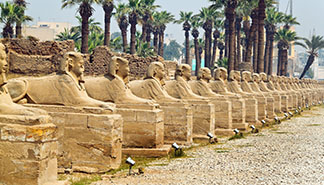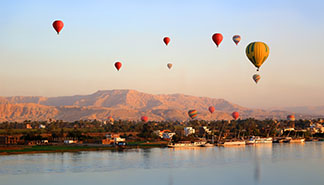Book Olympic Air Flights to Luxor
Explore lowest fares to Luxor
*Best fares for one way flights found by others.
More offers for flights to Luxor
*Best fares for one way flights found by others.
To Luxor
Plan your trip to Luxor
A journey through time awaits all those who visit Luxor, in the region that formed the core of Pharaonic grandeur and which is today the largest and most remarkable open-air museum in the world!
Visit to admire the magnificent monuments dotted on the banks of the River Nile, which remain untouched by time and can tell stories that are over 4000 years old… Wander through the Valley of the Kings, explore the tomb of Tutankhamun and marvel at the majestic temple of Hatshepsut, the only female Pharaoh in the history of Ancient Egypt!
At the same time, in the modern city of Luxor you can take in the atmosphere of a modern Egyptian city, which leaves an impression with its colourful houses, bazaars, liveliness and Eastern aromas.
Luxor is a unique tourist destination that it is well worth visiting. Make your dream a reality by booking your flights through the Olympic Air site!


Sightseeing in Luxor
The Luxor temple: Begin your visit at Corniche, the city’s coastal avenue from where you can admire the stunning Luxor temple. Dedicated to the god Amon, it dates from the 14th century BC. This sanctuary is preserved in an excellent condition, having been found beneath a thick layer of sand in 1885, and is guarded by two colossal statues of Rameses II.
El Kebas Road. In ancient Egypt, this road connected the complex of temples at Karnak with the Luxor temple. Important rituals took place here in the time of the Pharaohs. Walking along this 2.7-kilometre road is an awe-inspiring experience as you find yourselves watched by the vigilant eyes of 1,200 sphinxes, lined up on either side of the road.
The Luxor Museum contains some amazing exhibits, including the colossal red statue of Amenhotep III, alongside the crocodile god Sobek, and the Royal mummy of Ramesses I. In the Mummification Museum you can see a perfectly preserved mummy, that of the High Priest Amun. In this museum you will also be able to see the materials and tools used by the ancient Egyptians in the embalming process, as well as several stuffed animals.
Just as impressive is the sanctuary complex of Karnak, to the north of the city, which was not only a place of worship but also a regional economic centre. The central structure in the complex is the Precinct of Amun-Ra, dominated by the hypostyle hall with a forest of colossal columns among which once stood the daunting statues of the Pharaohs.
On the west bank of the River Nile lies the sacred resting place of the great Pharaohs and officials of ancient Egypt, the so-called Valley of the Kings. A total of 63 tombs have been discovered and it is impossible for the visitor not to marvel at the ornate burial chambers. Only a few are open to the public, however, the best-known being of that of Tutankhamun, whose mummy was placed in a grand sarcophagus made entirely of granite.
Also, on the west bank of the Nile is the striking temple of Hatshepsut, the only temple in ancient Egypt to be built in honour of a woman, and the Medinet Habu, a temple dedicated to Egypt’s last great Pharaoh, Ramesses III. The colossal statue of the Pharaoh at the entrance of the temple will leave you speechless. As for the temple of Hatshepsut, it must be remembered that she was the only woman to have declared herself and to have ruled as a Pharaoh! The temple dedicated to her is simple and symmetrical and so cleverly designed that it looks as though it’s the natural continuation of the rocks that crown it.
On the south side of the metropolis of ancient Thebes lies the valley of the Queens (also known as Ta-Set-Neferu, or “the place of beauty”), which contains a total of 75 tombs. Queens, princesses and other female members of the Pharaonic family were laid to rest here. The most eye-catching of all the tombs is that of Queen Nefertari, with its wonderful polychrome reliefs. The tomb was built by the pharaoh Ramesses II for his beloved and “most pretty” queen. This particular location may have been chosen as a burial site because of the sacred cave dedicated to the god Hathor at the entrance to the valley.

Things to do in Luxor
Go for a ride in a hot air balloon! How does it feel to fly over thousands of years of history? You can see this for yourself in a hot air balloon. There are several agencies in Luxor that will take you on an alternative “tour” of the city.
At a distance of 60 kilometres from Luxor, on the west bank of the River Nile lies atmospheric Aswan. Named after the dam built in 1970, Aswan is Egypt’s largest technical project and now belongs to the UNESCO Creative Cities Network, standing out in the category of crafts and folk art.
Entertainment in Luxor
There is no nightlife in Luxor with the usual meaning of the word. If you want to go out for the evening, you can visit the cafes of the Corniche on the east bank of the river and enjoy a “mocktail” (alcohol-free cocktail), coffee or an aromatic tea, served lukewarm, or even a belly dance show on the west bank. If you would like a drink, then you can have one in a hotel or restaurant.
An evening’s visit to the temple of Luxor, which is open until 10pm at night, is definitely worth it. Stroll as far as the souk, which is especially exciting at this time. It stays open until late and is even more lively in the evenings than during the day.
Most restaurants in Luxor serve western dishes, but you can also sample traditional eastern dishes, such as kebabs, humus, stuffed vine leaves, falafel and fried and baked fish from the River Nile and the Red Sea.
Shopping in Luxor
Shopping in Luxor is an experience that you will remember for the rest of your lives, and while some shop owners may become too heavy-handed, almost preventing you from leaving their shop without having bought something, others will let you have a look around undisturbed. If you want to buy something, then haggle over the price otherwise you will pay more than you need to.
To feel the pulse of the city, head for the souk of At Talaat, opposite the temple of Seti. In the weekly open-air market, filled with the colours and aromas of the East, you can buy fresh fruits and vegetables and beautiful handmade baskets.
Don’t leave Luxor without having sampled and bought kanafeh, a syrupy dessert made with thin vermicelli-like pastry and filled with vanilla cream or cream cheese. You can buy alabaster items at the Abo El Hassan Alabaster Factory. At the Fair Trade Centre, you will find wood carvings, necklaces, ceramics, aromatic oils, tablecloths, blown glass items, even ornaments made of recycled paper and glass from Cairo. Go to the Al Ayam bazaar for impressive embroidered shawls and traditional white galabeyas (men’s robes). Antiques lovers should head for the Farouk Gallery, with its remarkable selection.
Getting from the airport to Luxor
The only way to get from Luxor International Airport to the city centre is by private car or taxi. Be careful not to pay more than 40-50 Egyptian pounds if you are going to the east bank of the Nile or over 100 Egyptian pounds if your final destination is the west bank. The best option is to agree a fare with the driver before getting into the taxi. You can also hire a car from one of the car rental agencies in the airport arrivals lounge.
The ideal season in which to visit Luxor is winter, which resembles a cool, mild summer. Far from the crowds and the stifling heat of the summer, you will be able to enjoy the relaxed and serene atmosphere of a cruise on the River Nile.
Book your flights for Luxor at the Olympic Air site and enjoy a magical journey to the mysterious land of the Pharaohs!
